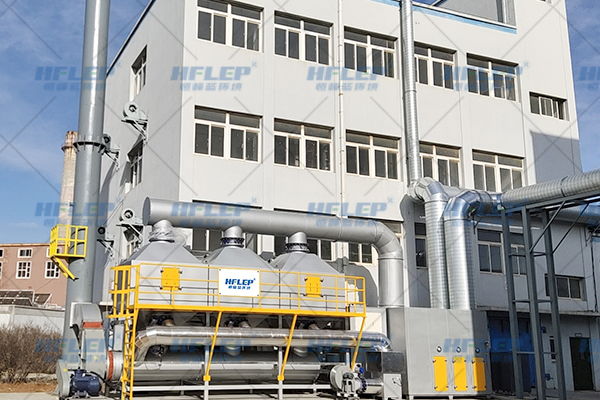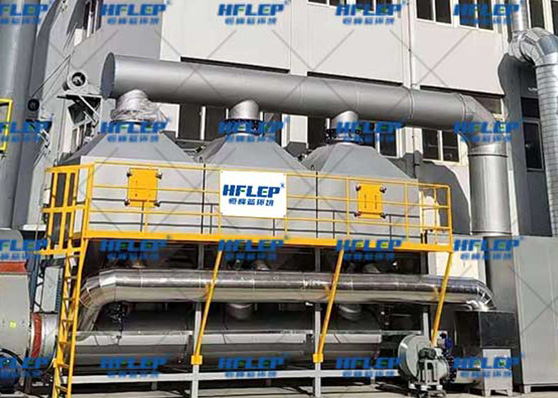
(physical works cases)
Industry Introduction
Packaging printing is the printing of all kinds of packaging materials as a carrier, printing decorative patterns, designs or text on the packaging, as a way to make the product more attractive or more descriptive, so as to play a role in conveying information and increasing sales. Including packaging cartons, bottles, cans and other packaging printing. Packaging printing in the printing industry and packaging industry have a large proportion, is an indispensable part of the packaging project. There are letterpress printing, plate printing, gravure printing, screen printing, hole plate printing and other printing methods. The main elements of printing are paper, ink, colour and so on.
Pollution Hazard
The main products of the packaging and printing plant in the production of a large number of coloured inks and organic thinners, these solvents in the production of the product as well as the drying process of organic compounds emitted, alcohol wetting liquid in the isopropyl alcohol, wireless gluing used in the hot melt adhesive, the volatile gases of the varnish coating and so on are polluted to the air, harmful to human health.
Overview of the treatment programme
Printing process exhaust with large air volume, low concentration, complex composition does not have the characteristics of the recycling value, if the printing process equipment is in the intermittent work occasions, it is recommended to use pre-treatment + adsorption and concentration + catalytic combustion treatment to meet the discharge standards.
Process flow

The process of this device is: adsorption concentration — desorption desorption — catalytic combustion process. Taking a single gas circuit mode of operation, by two activated carbon adsorption bed, a catalytic combustor (supplemented by low-pressure fans, valves and other components). Exhaust gas after pretreatment to remove dust, particulate matter, sent to the activated carbon adsorption bed A, when the activated carbon adsorption bed A is close to saturation, first of all, the processed gas will be automatically switched to the activated carbon adsorption bed B (the activated carbon adsorption bed A stops adsorption operation), and then the activated carbon adsorption bed A with the hot air flow of desorption and desorption, the organic matter from the activated carbon desorption down. In the desorption process, the organic waste gas has been concentrated, the concentration of the original dozens of times higher, up to 2000ppm or more, concentrated waste gas to the catalytic combustion device, and finally become CO2 and H2O discharge.
After completing the desorption and desorption, the activated carbon adsorption bed A enters into the standby state, and when the activated carbon adsorption bed B is close to saturation, the system automatically switches back to the activated carbon adsorption bed B at the same time for desorption and desorption, and so the cycle works.
When the concentration of organic waste gas reaches 2000ppm or more, the catalytic bed can maintain self-ignition, without external heating. This programme not only greatly saves energy consumption, but also reduces the investment in equipment at the same time because the processing capacity of the catalytic combustor is only 1/10 of the original waste gas processing capacity (3000m3/h). This programme is suitable for both continuous and intermittent work.
Desorption and depayment of a single activated carbon adsorber takes about 2-3 hours.
The adsorption fan is controlled by a frequency converter and can be adjusted according to the required air volume or the net negative pressure at the inlet of the plant.
Other treatment processes
Low concentration and small air volume of packaging and printing waste gas can be used: spray tower, uv photolysis purifier, activated carbon adsorption and other single or multiple combinations of processes for treatment;
High concentration of small air volume packaging and printing waste gas can be used: pretreatment + zeolite molecular sieve + catalytic combustion, pretreatment + zeolite molecular sieve + RTO thermal storage incinerator, a single catalytic combustion device or a single RTO thermal storage incinerator and so on;
High concentration and large air volume of packaging and printing waste gas can be used: pretreatment + zeolite rotor concentration + catalytic combustion or pretreatment + zeolite rotor concentration + RTO thermal storage incinerator and so on.
 Hotline
Hotline















